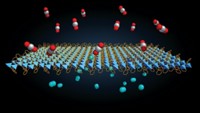Advertisement
Grab your lab coat. Let's get started
Welcome!
Welcome!
Create an account below to get 6 C&EN articles per month, receive newsletters and more - all free.
It seems this is your first time logging in online. Please enter the following information to continue.
As an ACS member you automatically get access to this site. All we need is few more details to create your reading experience.
Not you? Sign in with a different account.
Not you? Sign in with a different account.
ERROR 1
ERROR 1
ERROR 2
ERROR 2
ERROR 2
ERROR 2
ERROR 2
Password and Confirm password must match.
If you have an ACS member number, please enter it here so we can link this account to your membership. (optional)
ERROR 2
ACS values your privacy. By submitting your information, you are gaining access to C&EN and subscribing to our weekly newsletter. We use the information you provide to make your reading experience better, and we will never sell your data to third party members.
Materials
A Quick Two-Step Method To Make MOF Thin Films
Materials: Speed and ease of technique could enable applications of metal organic frameworks, researchers say
by Prachi Patel
October 15, 2012

Researchers have found a simple, fast way to make thin films of metal organic frameworks (J. Am. Chem. Soc., DOI: 10.1021/ja307953m). The two-step technique allows researchers to control the films’ thickness and could work with many types of the framework materials, known as MOFs. The advance could make it easy for scientists to use MOFs in hydrogen storage and gas sensors, the researchers say.
MOFs are crystalline materials that contain metal clusters connected by organic molecules. Their structure makes the materials very porous and gives them a large surface area. Because of these properties, researchers have studied them for storing hydrogen gas to fuel vehicles. Scientists are also interested in using the materials as catalysts and sensors, both of which require large surface areas. All of these applications would require MOFs in thin films of known thickness with regular, well-defined pores to allow molecules to easily diffuse through.
The best-known way to make such thin films, and to control the films’ thickness, is to grow crystalline MOF layers one by one on a substrate, says Hiroshi Kitagawa, a chemist at Kyoto University, in Japan. In addition to consuming time, this method isn’t compatible with all types of MOFs. Some MOFs require harsh synthetic conditions such as high temperatures and corrosive solvents. These conditions would destroy the substrate or the growing film itself.
Kitagawa and his colleagues avoid this problem by producing the MOF separately from growing the film. First, they prepare their MOF particles of choice in solution using the material’s synthetic conditions. Then they disperse the MOFs on the surface of water to produce a thin film. The team uses a rubber stamp to transfer the materials to a solid substrate. Because they place the films on the substrate after they’ve synthesized the MOFs, they don’t have to worry about the MOF production conditions destroying their growing film or substrate.
The researchers used this assembly method to make thin films of MOFs containing copper and a type of porphyrin. They first combined copper and the porphyrin compound in N,N-diethylformamide and ethanol to create MOF flakes. Using atomic force microscopy, the researchers found that the flakes were 300 to 500 nm in diameter and about 15 nm thick. They then dispersed the flakes in ethanol or acetone using ultrasonication. Drop by drop, the team added this suspension to the surface of water in a beaker. The flakes spread out to form a flat thin sheet, and the researchers used a stamp to lift the sheet and transfer it to a solid surface. They repeated the process to stack up layers of the sheets and make a film of a desired thickness.
The method is fast, Kitagawa says: His team could stack 100 layers of MOF sheets in 10 minutes. By contrast, the traditional method took them 10 minutes to produce a single layer.
Osama Shekhah at the King Abdullah University of Science and Technology, in Saudi Arabia, says the new method is convenient, which is important to researchers working on new applications of MOFs. He thinks the technique’s only drawback is that it applies only to two-dimensional, flake-shaped MOFs that can spread out into sheets on water. Kitagawa is working to apply the technique to MOFs with three-dimensional crystal structures.





Join the conversation
Contact the reporter
Submit a Letter to the Editor for publication
Engage with us on Twitter